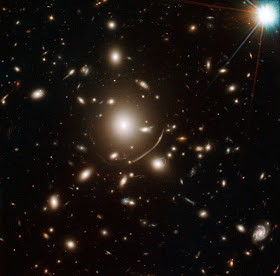ESA - Hubble Space Telescope logo.
26 October 2017
Observations may hint at nature of dark matter
Abell S1063, the final frontier
Using the NASA/ESA Hubble Space Telescope, astronomers have discovered that the brightest galaxies within galaxy clusters “wobble” relative to the cluster’s centre of mass. This unexpected result is inconsistent with predictions made by the current standard model of dark matter. With further analysis it may provide insights into the nature of dark matter, perhaps even indicating that new physics is at work.
Hubble image of galaxy cluster MACS J1206
Dark matter constitutes just over 25 percent of all matter in the Universe but cannot be directly observed, making it one of the biggest mysteries in modern astronomy. Invisible halos of elusive dark matter enclose galaxies and galaxy clusters alike. The latter are massive groupings of up to a thousand galaxies immersed in hot intergalactic gas. Such clusters have very dense cores, each containing a massive galaxy called the “brightest cluster galaxy” (BCG).
Lensing cluster Abell 383
The standard model of dark matter (cold dark matter model) predicts that once a galaxy cluster has returned to a “relaxed” state after experiencing the turbulence of a merging event, the BCG does not move from the cluster’s centre. It is held in place by the enormous gravitational influence of dark matter.
Brightest galaxy in Abell 2261
But now, a team of Swiss, French, and British astronomers have analysed ten galaxy clusters observed with the NASA/ESA Hubble Space Telescope, and found that their BCGs are not fixed at the centre as expected [1].
Galaxy cluster MACS J1720+35
The Hubble data indicate that they are “wobbling” around the centre of mass of each cluster long after the galaxy cluster has returned to a relaxed state following a merger. In other words, the centre of the visible parts of each galaxy cluster and the centre of the total mass of the cluster — including its dark matter halo — are offset, by as much as 40 000 light-years.
Wide-field image of Abell S1063 (ground-based image)
“We found that the BCGs wobble around centre of the halos,” explains David Harvey, astronomer at EPFL, Switzerland, and lead author of the paper. “This indicates that, rather than a dense region in the centre of the galaxy cluster, as predicted by the cold dark matter model, there is a much shallower central density. This is a striking signal of exotic forms of dark matter right at the heart of galaxy clusters.”
Wide field view of MACS 1206 (ground-based image)
The wobbling of the BCGs could only be analysed as the galaxy clusters studied also act as gravitational lenses. They are so massive that they warp spacetime enough to distort light from more distant objects behind them. This effect, called strong gravitational lensing, can be used to make a map of the dark matter associated with the cluster, enabling astronomers to work out the exact position of the centre of mass and then measure the offset of the BCG from this centre.
Pan across the galaxy cluster Abell S1063
If this “wobbling” is not an unknown astrophysical phenomenon and in fact the result of the behaviour of dark matter, then it is inconsistent with the standard model of dark matter and can only be explained if dark matter particles can interact with each other — a strong contradiction to the current understanding of dark matter. This may indicate that new fundamental physics is required to solve the mystery of dark matter.
Pan across Abell 383
Co-author Frederic Courbin, also at EPFL, concludes: “We’re looking forward to larger surveys — such as the Euclid survey — that will extend our dataset. Then we can determine whether the wobbling of BGCs is the result of a novel astrophysical phenomenon or new fundamental physics. Both of which would be exciting!”
Pan across MACS 1206
Notes:
[1] The study was performed using archive data from Hubble. The observations were originally made for the CLASH and LoCuSS surveys.
More information:
The Hubble Space Telescope is a project of international cooperation between ESA and NASA.
This research was presented in a paper entitled “A detection of wobbling Brightest Cluster Galaxies within massive galaxy clusters” by Harvey et al., which appeared in the Monthly Notices of the Royal Astronomical Society.
The international team of astronomers in this study consists of David Harvey (Laboratoire d’Astrophysique EPFL, Switzerland), F. Courbin (Laboratoire d’Astrophysique EPFL, Switzerland), J.P. Kneib (Laboratoire d’Astrophysique EPFL, Switzerland; CNRS, France), and Ian G. McCarthy (Liverpool John Moores University, UK).
Links:
Images of Hubble: http://www.spacetelescope.org/images/archive/category/spacecraft/
Science paper: http://www.spacetelescope.org/static/archives/releases/science_papers/heic1718/heic1718a.pdf
CLASH: http://www.stsci.edu/~postman/CLASH/Home.html
LoCuSS: http://herschel.as.arizona.edu/locuss/locuss_background.html
ESA Hubble site: http://www.spacetelescope.org/
Image Credits: NASA, ESA, J. Lotz (STScI), M. Postman (STScI), J. Richard (CRAL) and J.-P. Kneib (LAM), T. Lauer (NOAO), S. Perlmutter (UC Berkeley, LBNL), A. Koekemoer (STScI), A. Riess (STScI/JHU), J. Nordin (LBNL, UC Berkeley), D. Rubin (Florida State), C. McCully (Rutgers University) and the CLASH Team/Digitized Sky Survey 2 (Acknowledgement: Davide De Martin)/Text Credits: ESA/Hubble/Mathias Jäger/Laboratoire d’Astrophysique EPFL/Jean-Paul Kneib/Frederic Courbin/David Harvey/Videos: ESA/NASA/Hubble/J. Richard (CRAL) and J.-P. Kneib. Acknowledgement: Marc Postman (STScI) and the CLASH Survey Team/Music: Johan B. Monell (http://www.johanmonell.com).
Best regards, Orbiter.ch








